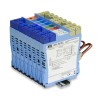4-20mA Current loop output is a type of electrical signal that is used in a series circuit to provide a robust measurement signal.
The sensor or instrument generating the signal acts like a current source providing a constant current output signal for a given measurement independent of supply voltage or circuit impedance.
Unlike voltage outputs, the current output is the same at any particular point in the circuit and is a relatively high power analogue output which can be used in measurement circuits over long distances.
A typical current output is 4 to 20 mA in a 2 wire configuration, but there are 3 wire configurations which can provide 0 to 20mA or 4 to 20mA current loop output signal with a separate positive supply and output connection.
Featured 4 to 20 ma current loop signal measurement products
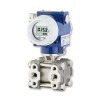 Differential Pressure Transmitters - Differential pressure transmitters for measuring the DP of fluids and gases across particle filters and along a length of pipe to monitor flow.
Differential Pressure Transmitters - Differential pressure transmitters for measuring the DP of fluids and gases across particle filters and along a length of pipe to monitor flow.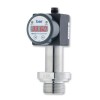 DS200P Sanitary Low Range Pressure Gauge, Switch and Sensor - All in one electronic switch, gauge and sensor designed specifically for use in the food, drink and biomedical industry for measuring process pressures.
DS200P Sanitary Low Range Pressure Gauge, Switch and Sensor - All in one electronic switch, gauge and sensor designed specifically for use in the food, drink and biomedical industry for measuring process pressures.
The current can be converted to voltage output for measurement purposes at any point in the circuit by adding a load resistor in series. The voltage drop across the resistor will then vary proportionally with pressure and current. For example a 250 ohm resistor will produce a 1 to 5 volt output signal with 4-20mA current loop signal.
When connecting up a 4-20mA transmitter to a circuit with a measurement load resistor it is important to ensure that there is sufficient supply voltage available across the transmitter positive and negative supply contacts particularly at full scale output.
4-20 milliamps is used extensively throughout the process control industry and is also being increasingly used for manufacturing, aerospace and automotive applications because of the convenience of 2 wire connections, robustness to RFI, and similar size to other types of output devices .
Featured 4 to 20 ma current loop signal measurement products
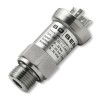 DMP331 Precision Pressure Transmitter - Stainless steel pressure transmitter with ranges from 100mbar up to 40 bar gauge or absolute. Special options for ATEX , SIL2 and compound ranges.
DMP331 Precision Pressure Transmitter - Stainless steel pressure transmitter with ranges from 100mbar up to 40 bar gauge or absolute. Special options for ATEX , SIL2 and compound ranges.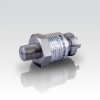 Low operating temperature plus/minus 1 psi pressure transmitter - Reliable pressure measurements down to -40°C. Ideal for low range applications with a -1 to +1 psi gauge range.
Low operating temperature plus/minus 1 psi pressure transmitter - Reliable pressure measurements down to -40°C. Ideal for low range applications with a -1 to +1 psi gauge range.
4-20mA Help
Understanding supply voltage for 2-wire 4-20mA pressure transmitters
The datasheet for my 2-wire 4-20mA pressure transmitter indicates a supply voltage range of 8 to 32 VDC. My system provides a stable 23VDC. How does operating in the middle of this range, rather than at the maximum voltage, affect the sensor’s accuracy and performance?
Operating a 2-wire 4-20mA transmitter with a 23VDC supply is perfectly acceptable and will not negatively impact its performance or accuracy, as this voltage falls well within the typical 8 to 32 VDC operational range. The specified range defines the voltages required to correctly power the sensor’s internal electronics.
The two key factors to consider regarding supply voltage are:
- Loop Load Capacity: The supply voltage must be sufficient to power the sensor (which requires a minimum of 8V in this case) and also overcome the voltage drop caused by any resistance in the measurement loop (e.g., from the input card of a data logger or PLC). With a 23V supply, there is ample voltage to support a significant load resistance, making it compatible with most industrial control and monitoring equipment. The maximum permissible load resistance (RL) can be calculated using the formula: RL ≤ (VS − VSmin) / 0.02A
- Supply Voltage Stability: The accuracy of the sensor can be slightly affected by fluctuations in the supply voltage. As an example, a specification for this effect may be quoted as ≤ ±0.05% FSO / 10 V. This means that if your power supply were to change by a full 10 volts, the sensor’s output might shift by a maximum of 0.05% of its full-scale range. Since your power supply is a stable 23VDC, you will not experience any noticeable change in output, and the sensor will perform to its specified accuracy.
2 wire 4-20ma pressure transmitter wiring configuration
The diagram below below shows a simple wiring configuration for current loop pressure transmitter. It is assumed that the measurement device includes a sufficient load resistance for measuring a current loop. If the measurement device is a multi-meter it is unlikely to include sufficient load resistance, so in this case you will need to include a separate load resistor, e.g. 250Ω added in series to the current loop.
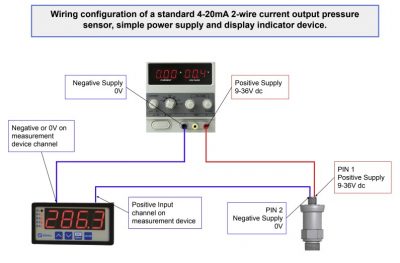
Series or parallel 250Ω resistor to create 1-5Vdc from 4-20mA
If a 4-20mA signal is connected to a DCS circuit that accepts a 1-5 Vdc input, which of these statements are correct?
- Connect 250 Ohms resistor in parallel
- Connect 250 Ohms resistor in series
Either statements can be true because it depends on which part of the circuit you are referring to.
Statement 1 would be true if you were relating the connection of the resistor to the 1-5Vdc signal input – Connect 250 Ohms resistor in parallel with the 1-5Vdc input wires.
Statement 2 would be true if you were relating the connection of the resistor to the current loop circuit – Connect 250 Ohms resistor in series with the 4-20mA current loop circuit.
If you were to ask what is the most usual way of describing how a 4-20mA current loop signal is converted to a 1-5Vdc output signal, then statement 2 would be the one that most people use.
2 & 4 wire comparison
What is difference between a two wire and a four wire 4 to 20 milliamp transmitter?
Two wire 4-20mA transmitter will have a single loop circuit with the transmitter [+/-], power supply [+/-] and signal conditioning unit (SCU) [+/-] all connected together in series.
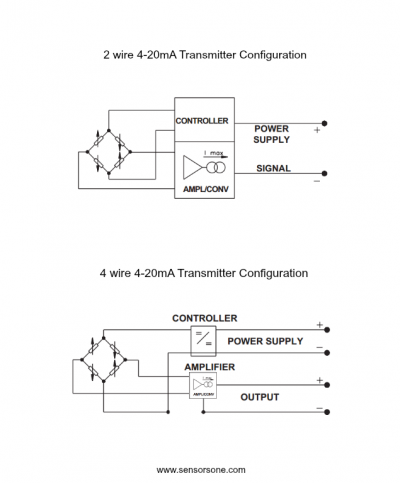
Four wire 4-20mA transmitter will have a separate output and supply circuit. The transmitter output +/- will be connected to the SCU +/-. The transmitter supply +/- will be connected to the power supply +/-.
Convert 4-20mA to 1-5 volt output
I have a pressure transmitter with an output of 4-20mA / 2 wire. How could I change this current output to a voltage output?
Add a load resistor in series with the current loop and then measure the voltage drop across the load resistor.
For example a 250 ohm resistor will convert a 4-20mA signal to 1 to 5 Vdc.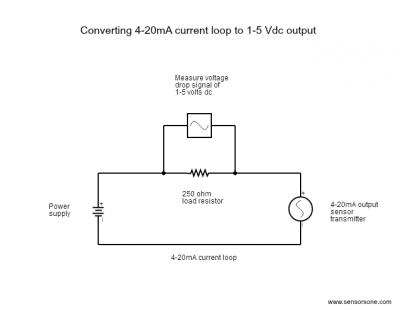
Also note that you will need to allow for the required additional power supply of 5 volts over the sensor’s minimum supply voltage of 9 Vdc, to allow for the extra load resistance.
Why start from 4mA and not lower
Why do current loop transmitters provide a signal which starts from 4ma and not below this?
4-20mA is normally a 2 wire current loop and in order for the device to operate it needs to consume some of the current to function, and this is provided by the minimum current of 4mA.
Also it is useful to know whether the current output device is functioning, unlike a 0-10Vdc signal for example, a zero mA signal would suggest there is a failure in the current loop circuit at some point.
4mA vs 0mA
Why do current loop transmitters provide a signal which starts from 4ma and not 0mA?
The main reason is that 4-20mA is normally a 2 wire current loop and in order for the device to operate it needs to consume some of the current to function, and this is provided by the minimum current of 4mA.
Featured 4 to 20 ma current loop signal measurement products
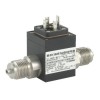 DMD331 Compact Differential Liquid Pressure Sensor - Wet wet differential pressure sensor with a high overpressure rating on both positive and negative pressure side for protection against damage.
DMD331 Compact Differential Liquid Pressure Sensor - Wet wet differential pressure sensor with a high overpressure rating on both positive and negative pressure side for protection against damage.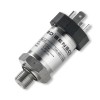 DMK457 Marine Approved Pressure Transmitter - Marine approved pressure transmitter with 4-20mA current loop output for shipbuilding with optional CuNiFe housing for sea-water compatibility
DMK457 Marine Approved Pressure Transmitter - Marine approved pressure transmitter with 4-20mA current loop output for shipbuilding with optional CuNiFe housing for sea-water compatibility
Glossary of Measurement Signal technical terms
- 2 Wire
- 3 Wire
- 4 Wire
- Amplified Voltage Output
- BFSG – Bonded Foil Strain Gauge
- Deadband
- FSO – Full Scale Output
- HART®
- mV/V – Millivolts per Volt Output Signal
- NC – Normally Closed
- NO – Normally Open
- Piezoresistive Strain Gauges
- Ratiometric
- Span
- Span Offset
- Span Sensitivity
- Square Root Extraction
- Threshold
- Totalizer
- Transducer
- Transmitter
- TSL – Terminal Straight Line
- TSS – Thermal Span or Sensitivity Shift
- Turndown Ratio
- USB
- Vented Cable
- Wheatstone Bridge Strain Gauge
- Zero Offset
- Zero Tare
Help from Measurement Signal resources
- Why use 4-20mA and 3-15 psi rather than 0-20mA & 0-15psi
- Supply voltage and load resistance considerations for pressure transmitters
- What is the difference between zero offset and zero drift?

